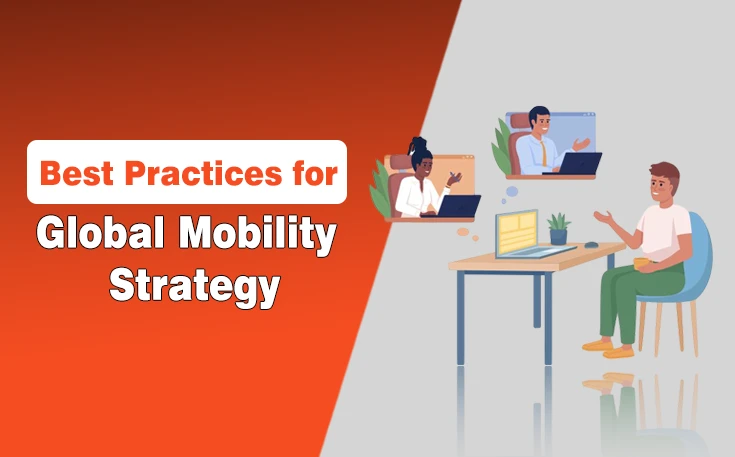In this modern era, employees want freedom in their jobs. They desire to schedule time and place according to their own choice, and also demand trust from the company. That is why, the global mobility strategy came into existence.
Many companies are adopting it to fulfil their individual business needs. It allows companies to transfer their employees worldwide for business purposes. These transfers could be short-term, long term or permanent based on the importance of the project or assignment.
In this guide, learn what it global mobility and best practices for global strategy.
What is Global Mobility? – Definition
Global mobility is an efficient plan for a company to relocate its employees overseas with the assigning of new job roles and opportunities. It is a detailed plan organized in a way that facilitates the successful relocation of its employees.
It is a step-by-step guide in which every process is explained in detail which results in reaching the destination successfully.
Global mobility enables businesses to expand their operations and take advantage of talent worldwide, making it a critical component of global business strategy. Often, this process requires essential steps like background verification citizenship checks to ensure employee compliance across borders.

What Is Included In The Global Mobility Strategy?
Every mobility plan is different from others as it varies from country to country according to various rules and regulations. Companies need to build an effective global mobility plan by utilizing their resources.
Here are the key factors that must be included while making a mobility plan:
1. Immigration Laws
The plan must include all the rules and regulations of the countries that are required during the relocation of your employees. It also includes comprehensive guidance on every law and how to obey it. These rules and regulations may vary based on the country in which your employees are going to relocate.
Therefore, you must be careful and provide all the relevant information so that your employees do not experience any difficulty during the transfer.
2. Tax Obedience
The plan also includes all the information and guidance related to various taxes that your employee needs to pay during the process of transfer. The plan must contain information about how much money their employees need to pay, to whom they need to pay the tax amount, in which currency this tax can be paid, etc.
For U.S.-origin assignees, ensure coverage of IRS obligations such as FBAR, FATCA, and the Streamlined Foreign Offshore Procedures. When past filings were missed, HR can direct employees to resources for streamlined tax filing for expats that provide guided questionnaires, Form 14653 preparation, and FBAR e-filing, helping regain compliance with minimal disruption to assignments.
3. Physical Repositioning
The global mobility plan may includes all the relevant and step-by-step guidance that helps employees relocate themselves easily without facing any trouble throughout the process.
It must contain proper information about arranging their employee’s visas, and permits, arranging accommodations where they are being relocated, and successfully transferring their families with them.
4. Benefits Offered By The Company
Many companies also offer various benefits to their employees when relocating from one country to another. It is very difficult for employees to leave their home country for work, and these offerings provide some relief and motivate them to go abroad.
That is why numerous benefits and rewards are offered to them and also mentioned in their mobility plan.
5. HR Management
The HR department of a company develops various plans related to career development to retain employees all over the world. Therefore, it is extremely effective to mention all the policies and plans in their mobility plan so that, their employees must be aware of them in advance.
These plans consist of promotions, downgrading, job changes, new positions, working on additional projects, etc.
5 Best Practices of Effective Global Mobility Strategy
Almost 40% of international relocation of employees failed in the past according to a research. This failure causes a lot of damage to businesses and they face financial losses. This cost differs from company to company as it is based on the country’s location where its employees were relocated.
Most of these failures were caused due to improper policies and management negligence. Now it’s time to learn from the previous mistakes and improve the global mobility policies.
Here are some best practices from which companies can optimize their Global Mobility plan:
1. Improve Employee’s Experience
Many companies focus on eliminating the costs required for global transfer. However, companies need to provide additional benefits to their employees that fulfil their expectations by improving the overall experience.
Employers need to facilitate their employees as much as they can to improve their employees’ work in that country. Companies can provide various facilities like housing, schooling of their children, improved salary packages, and job employment for their spouses.
2. Implementation of The Right Technology
For effective global mobility, you need to implement the right tech tools that help in the proper estimation of various operational and international transfer costs. These modern tools further help in gaining effective forecast revenue, preparing a budget for relocation, and analyzing other international operations.
Companies need to adopt modern technologies to ensure robust communication with their relocated employees. It will improve the overall experience of the company also.
3. Supplier Consolidation
This strategy is being adopted by various companies because it helps them to reduce their overall expenses. It allows them to reduce the number of vendors from which they are acquiring various facilities for their employees.
Mobility processes require a lot of facilities like the transfer of logistics, target facility providers, and more. Companies can save a lot of their money by analyzing the costs and tracking the performance of each service that they acquire. They can also execute surveys to evaluate the quality of their services.
4. Schedule Structuring
It takes some time for employers to adjust their schedule of working according to the changed time zone of their country. Companies need to set schedules that are effective for their employees and suit them best for work.
Many employers make changes to their schedules according to their relocated employee’s time zones for effective communication between them. It is highly recommended to locate your office near to your other employee’s residence. It helps them to communicate according to their relocated employees’ time zone and can easily adjust their working hours accordingly.
5. Effective Evaluation Of International Requirements
For every company, it is essential to analyze each international requirement that is needed for the replacement of their employees from one country to another. You need to make sure that your global mobility plan covers all these requirements like settlement, taxes, citations, help required in the host country, etc.
It enables efficient transfer of employees and they cannot be able to face any difficulty during the entire process. It also encourages other employees to acquire various international opportunities offered by the company.
Bottom Line
Well, it is difficult for employers to make their mobility plans more effective. However, they strive to make it a robust plan and make sure their employees are not impacted during the entire process. You can also improve the global mobility strategy over time after building it. Many companies collaborate with other facilitators during the relocation process.
They provide effective solutions to every task whether it is payroll requirements, providing benefits to employees, insurance, and multi-currency payments. An effective mobility plan allows you to track assignments, talent management, communication, and collaboration with relocated team members worldwide.
Need custom app with amazing features?
Get a Quote




